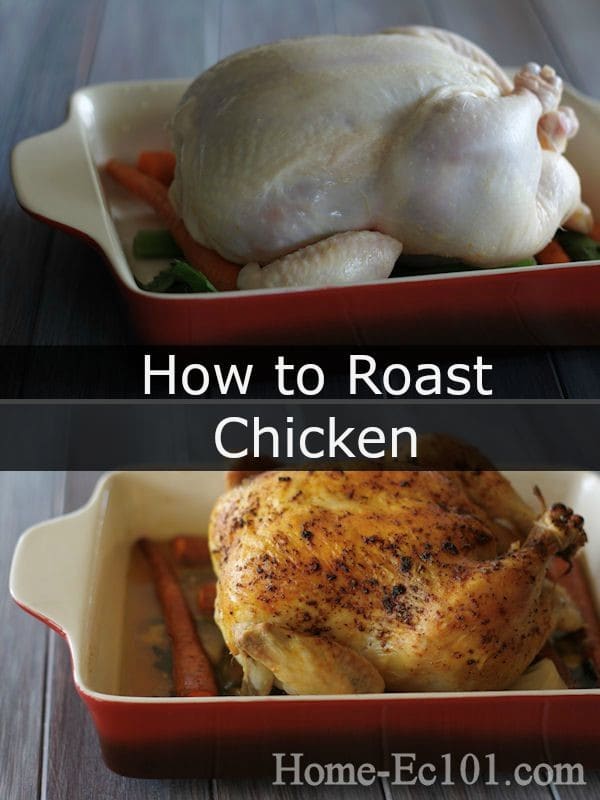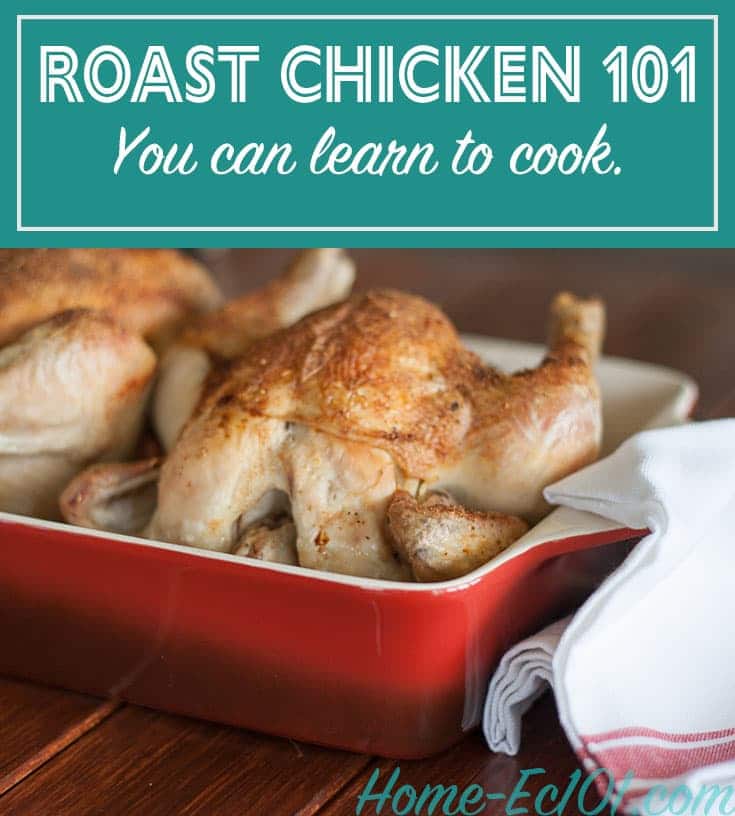 Heather says:
Heather says:
Here at Home Ec 101, we get many questions about stretching those grocery dollars. One of my personal favorites is how to roast chicken. You can get a lot of bang for your buck when you buy whole chickens. As you choose your chicken, be sure to watch the amount of salt water solution injected. You don’t want more than 5%. The saltwater itself isn’t bad. You just don’t want to be paying for a lot of weight that isn’t meat.
The chicken in today’s example was 5lbs, and I’ll be using it for three meals*.
*Important note – this was written back in 2007, back when I only had two very young children. One five-pound chicken doesn’t cut it at this point, and I roast them two at a time if I want to have a chance of any leftovers.
Also, the bones will later be used for homemade stock. It is important to consider seasonings carefully when deciding on the future use of the bird. In this example, I have the original meal, chicken salad, and stir fry. With this in mind, I chose not to go crazy with an exotic rub. However, spice rubs can be fun, and I will link to several of my favorites after the recipe.
When preparing to roast a chicken, I first preheat the oven to 350. I then remove the bird from its packaging and give it a thorough once over in the sink. Check for pin feathers or any large fatty areas that can easily be trimmed.
Never forget to remove the giblets! I don’t eat them, but some people swear giblet gravy is the only way to go. I’ll leave that to your discretion.
We’ll tackle gravy on another day. Which I finally got around to, only 14 years later…

Slather the chicken with 1 – 2 TBSP of olive oil. Don’t be scared to use your hands and get all of the crevices. The fat is what keeps the bird moist and ensures basting is unnecessary. Rub the bird with your choice of spices. The chicken in the picture above example was rubbed with Chef Paul Prudhomme’s Blackened Redfish Magic, one of my favorite seasoning blends. (I served the meal with baked sweet potatoes, roasted carrots and onions, and dressing.)
Place the chicken in a heavy roasting pan or large casserole dish. Make sure the pan is deep enough to contain two or three cups of liquid in addition to the bird and any vegetables. I like adding potatoes, carrots, and onions to the pan. As a final touch, I usually add a few slices of onion and a sliced clove of garlic to the cavity.
The vegetables will absorb some of the juices and a lot of flavor from the chicken. Be careful not to overload your pan. A crowded pan can increase the cooking time.
The bird will need to be roasted for approximately twenty minutes per pound. Check on the bird occasionally (with the light, not by opening the door). If the skin starts to brown too quickly, tent the bird with aluminum foil. Fold foil into a tent shape and place it over the breast to protect it from direct heat.
Remove the bird from the oven and check the temperature with a meat thermometer. Poultry needs to be cooked to an internal temperature of 165*. It is important to note that the bird’s internal temperature will rise for 5 to 10 minutes after it has been removed from the oven. Don’t despair if the temperature reads 163; it will reach 165 before carving. Remove the bird from the tray and set it on a cutting board, preferably one with a well around the edge to catch drippings.
If you had vegetables in the pan, check them for doneness and return them to the oven if necessary.
Enjoy your first meal. Let the chicken hang out in the fridge while you eat.
After dinner, come back to your chicken. Separate the meat from the bones and store it refrigerated in tightly sealed containers. I toss the remaining carcass in a large freezer bag and wait until it’s been joined by a friend or two before preparing stock.
Recipes for the leftover meat will follow over the next few days.
Enjoy these additional ideas for seasoning roast chicken:




Why would it be bad to open the door during cooking? I have a burned out oven light at the moment! BTW – gorgeous bird it the pics!
You picked one of my favorite cheap meal. Roasting a whole chicken is really easy and satisfying, and it makes the whole house smell delicious.
One of my favorite things to do with the leftover chicken (or any leftover chicken, meat or fish) is to make fried rice. I will have to post a recipe when I do it with that half eaten steak I have in the fridge. Or, I can let it sit for a while and then send y’all the pictures.
Foodie, when you open the door, you lower the oven temperature and the element must turn on for more/extended periods of time. This exposes the bird to more direct heat than if if were left alone.
Hilary, we love fried rice in our house, as well. Would you share the recipe? We can skip the science project.
Your chicken looks divine, and has me running to the freezer to get one thawing for dinner.
Anyway, when I roast my chicken, I roast it upside down for juicy breasts, and put it in a tent made out of a seasoned brown paper bag. It helps the chicken to stay moist and acts as a self baster. Yummy. For the last 45 mins. to 1 hour I take off the tent and flip over the chicken to brown it nicely.
Thank you so much for posting this. I am making my first roasted chicken with potatoes and carrots and this it the best advice I have found that is simple and looks delicious. I’m not much of a cook. I enjoy baking instead. Cant wait to try this out. But nervous at the same time : ).
I agree Heather, whole chicken is the way to go easy on your wallet. Curious, how can you tell which chicken has over 5% sodium solution injected in it? Is there a lot of chicken in the market as such? Do you have any brand names I should know of?
My mouth is salivating!
One method I’ve found to penny pinch is to avoid supermarkets.
At supermarkets, you can get around 5 onions for £1. At the markets down in Tooting you can get a big sack (that won’t fit in a rucksack). The herbs and spices are also less than half the price.
(I live in the UK, and don’t know if this tip works in the US).
This looks yummy…,but I have a question for anyone out there. I just got back from the grocery store and was looking at the whole chickens – the smallest, least expensive one I could find was $5.78. Then I went to the deli and saw the price on their whole, already roasted chickens…$5.00. Any reason why I should go to the trouble and clean-up of roasting my own rather than opting for the already roasted variety? Thanks!
i love chickies
Whole chickens can go on sale for significantly cheaper, also compare the weight of the chickens. Last, sometimes people have allergies, intolerances, or just plain don't like the seasoning mix used to season some rotisserie chickens.
Also roasting a chicken is a great confidence builder for those just learning to cook.
What KIND of chicken does one buy?
@danagirl Hi Danagirl ~ You can usually find whole birds in the meat department of your grocery store. They may not be big sellers in your area and may not be in prominent grocery store real estate…so if you can’t find them ask a butcher.
They are often called “roasting hens,” “fryers,” “whole fryers” or “stewing hens.” Here is a great site that photo-documents the stages of the names of the cuts from the whole bir: http://www.chicken.org.au/page.php?id=12
I hope this helps!
I've cook chicken for years in so many different ways. I am so glad that I checked on-line, there is something good to be said about returning to the basics; THANKS, & The Cooked chickens in the Deli- are awesome, and excellent time savers… But there is nothing better than HOME-COOKED…EVERYONE HAVE AN EXCELLENT DINNER!!!
Thank you for your post I am going to try it as well it going to be yummy anyone like to come to dinner
that’s really hotilicious chiken. thanks heather for sharing wonderful recipe
CCB ~ I have the same issue! It costs only a few cents more to purchase the roasted chicken. I’d rather pay a few cents than have the mess to clean.
Thanks for this easy recipe. I have been roasting chickens for years, but they always seem to turn out very dry, or slightly burnt! I am trying again though & appreciate the simple directions!